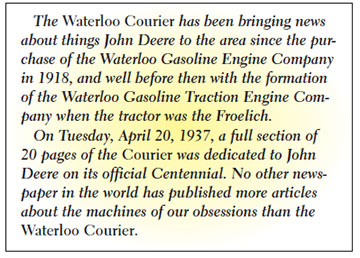with factory power steering. His runs on LP, a much
cheaper fuel than gasoline.
DeRycke, though, also wanted to stand out in the
green and yellow crowd. So the “50” supports a two-row
cultivator.
“It just adds extra interest, something else for people
to look at,” he said.
“You walk down through here and after a while the
tractors start to look alike,” DeRycke added.
Another of his projects also answers a familiar question
at tractor shows: What did that look like before
restoration?
DeRycke fixed and repainted one side of an “H” built
in 1945. The other side still has its chore clothes on and
remains a dented, rusty, scratched, oily and faded green.
O’Connor’s combine is meticulously redone, down to
aligning the slots on hundreds of screw heads: Each is
perfectly vertical.
The entire restoration took more than three years and
required a team effort, according to O’Connor.
“A lot of parts had to be made,” he says.
O’Connor’s Model 60 Auger Wagon built in 1960 was
parked nearby. The implement was designed to deliver
feed but became the forerunner of today’s grain carts
used at harvest. |
The auger wagon holds 125 bushels, less than half
what a typical modern combine can carry in its hopper.
Caught up on all his restoration projects at the
moment, O’Connor, 72, hedges on what is next in line.
“My wife asks that every once in a while. Her question
is, ‘How many tractors does a man need?’ — It’s an
interesting and complicated answer.”

Jack Vinopal of Mauston, Wisconsin, and his sons put three tractors
on display during the Two-Cylinder Expo XXIII at the
National Cattle Congress. He spent part of Friday answering questions
about a two-way plow attached to an “M” built in 1947.
|





